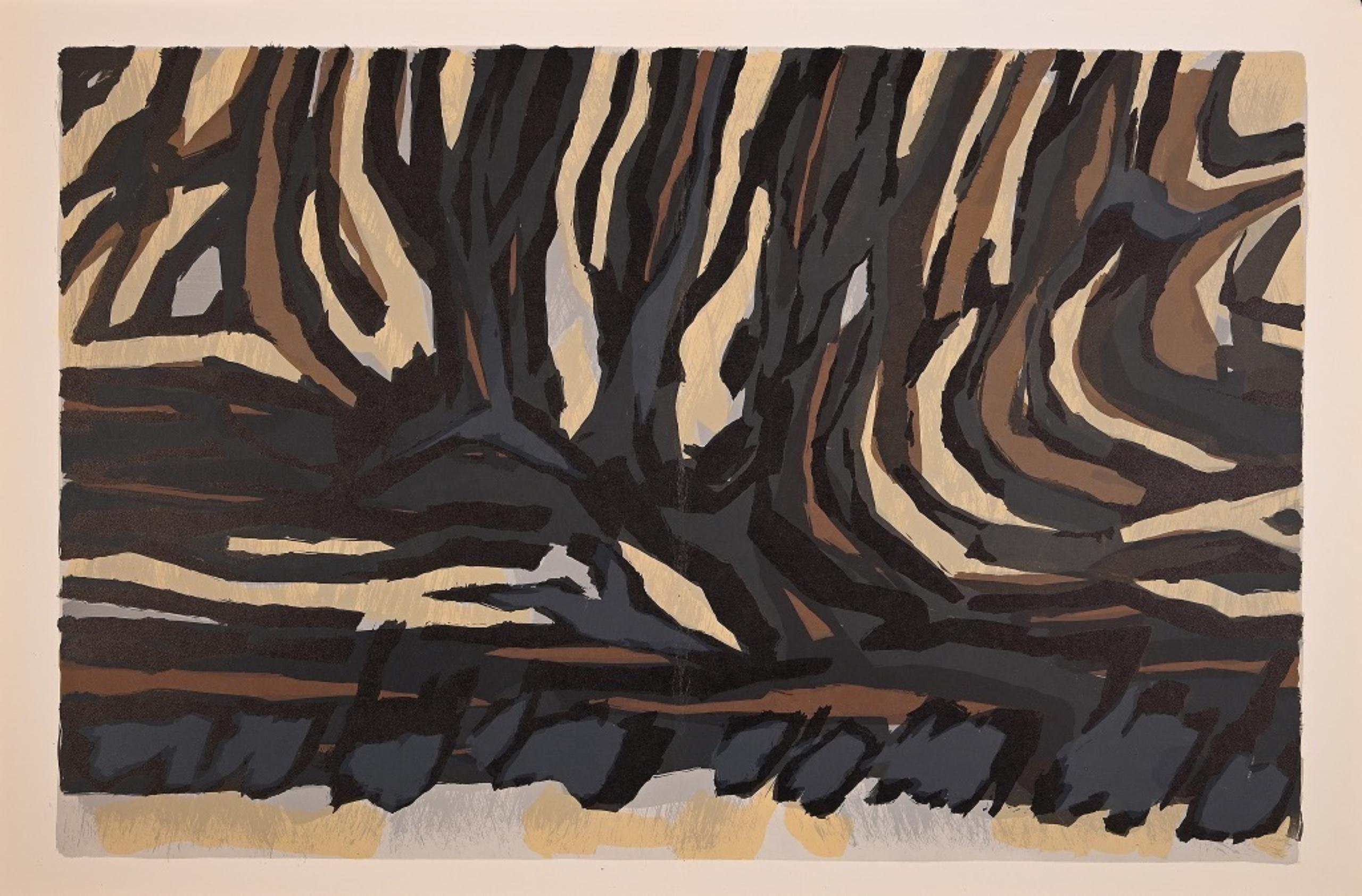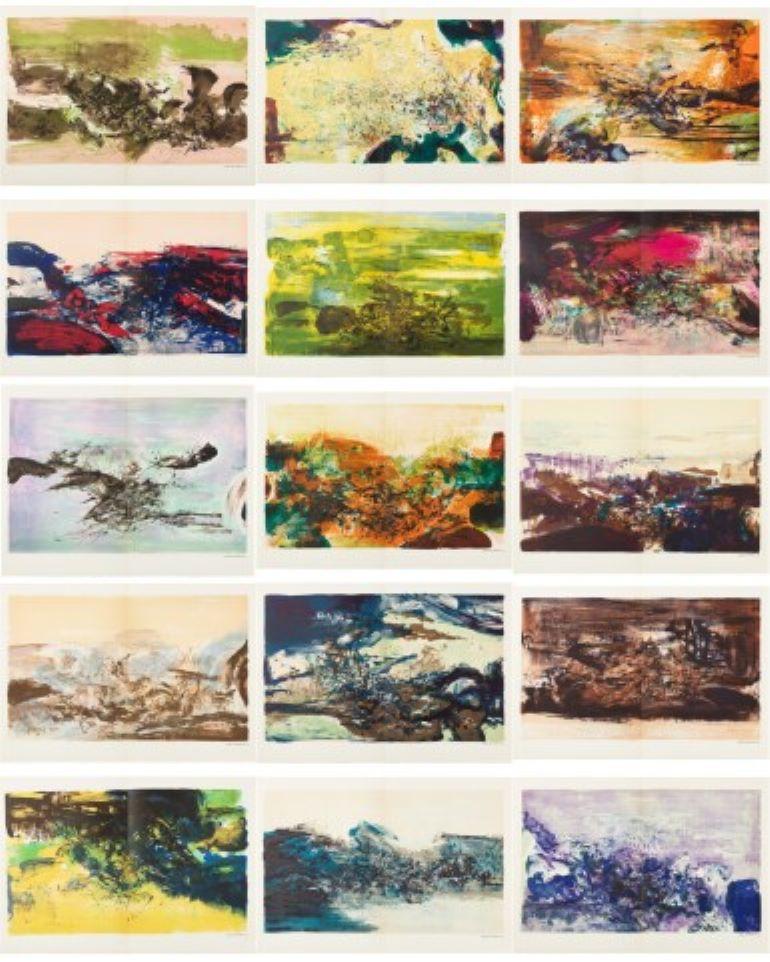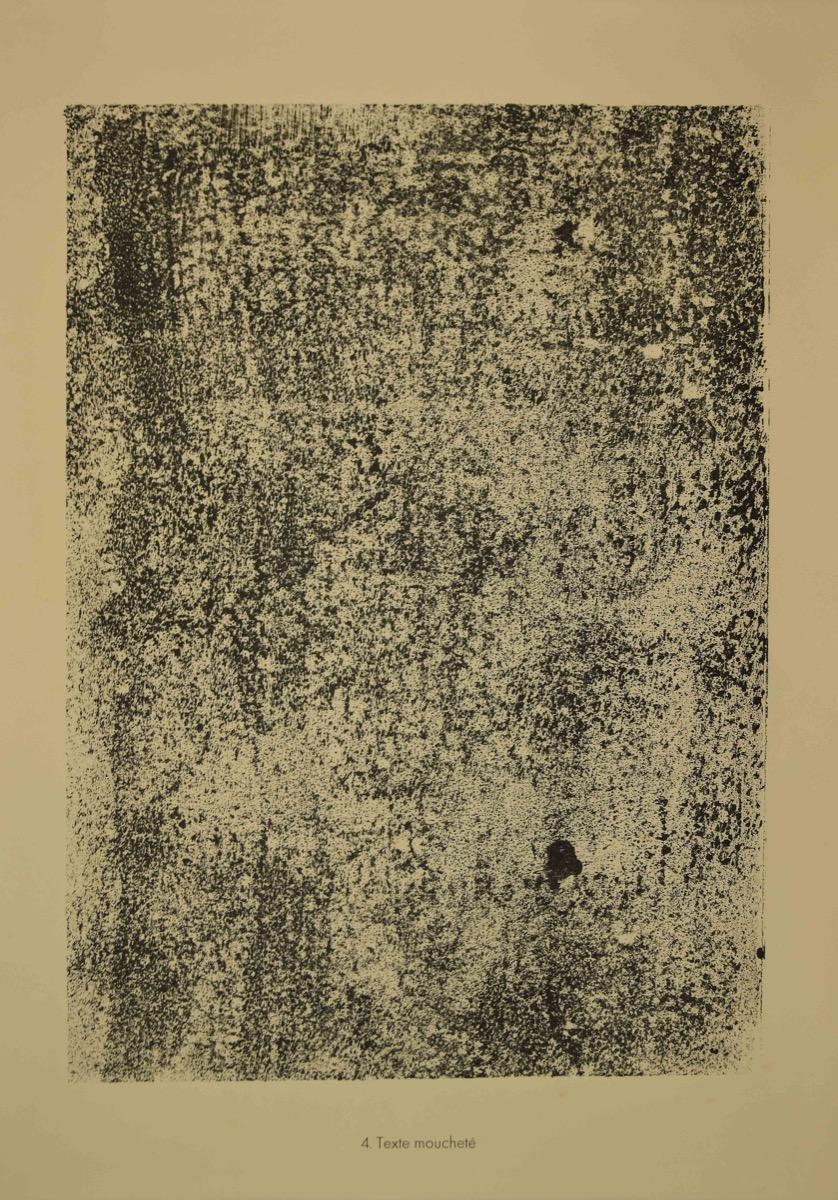Zao Wou-Ki"Hommage a Nobutaka Shikanai, " Zao Wou-Ki, Abstract Lithograph Mid-century Print1991
1991
About the Item
- Creator:Zao Wou-Ki (1921, Chinese)
- Creation Year:1991
- Dimensions:Height: 31 in (78.74 cm)Width: 23.5 in (59.69 cm)
- Medium:
- Movement & Style:
- Period:
- Condition:
- Gallery Location:New York, NY
- Reference Number:1stDibs: LU184129905442
Zao Wou-Ki
Zao Wou-Ki was born in Beijing, China, on February 13, 1921, to a wealthy family descended from the Song Dynasty.
French-educated Chinese artist Lin Fengmian was Wou-Ki’s teacher at the China Academy of Art from 1935–41 and encouraged him to study abroad in Paris. Wou-Ki made the move in 1948 with a substantial amount of financial backing and later adopted France as his new home, remaining in the country, besides a few short trips abroad, until his death.
In Paris, Wou-Ki quickly joined a large postwar French art circle, composed of key writers, poets, painters and cultural figures, including Joan Miró, Pablo Picasso, Riopelle and Vieira da Silva, among others. This networking helped position himself at the top of the Lyrical Abstraction movement. By his mid-30s, Wou-Ki had decided to devote his artistic career to abstract painting that blended Eastern and Western stylistic traditions.
In 2011, Wou-Ki was referred to in art publications as the top-selling living Chinese artist. He died in Nyon, Switzerland, on April 9, 2013, at the age of 93.
Find authentic Zao Wou-Ki prints and other art on 1stDibs.
- ShippingRetrieving quote...Ships From: New York, NY
- Return PolicyA return for this item may be initiated within 3 days of delivery.
- "The Little Tree" Joan Mitchell, Abstract Expressionist, Female ArtistBy Joan MitchellLocated in New York, NYJoan Mitchell The Little Tree, 1992 Four color lithograph on wove paper Sheet 8 x 7 inches Published by Tyler Graphics. Mount Kisco, NY In unsigned edition...Category
1990s Abstract Expressionist Abstract Prints
MaterialsPaper, Lithograph
- "Rembrandt Later Danae, " Alan Fenton, Abstract ExpressionismLocated in New York, NYAlan Fenton (1927 - 2000) Rembrandt Later Danae, 1975 Watercolor on paper 23 x 17 inches Signed and dated lower right; titled lower left Fenton's quiet an...Category
1970s Abstract Expressionist Abstract Paintings
MaterialsPaper, Watercolor, Gouache
- "Colorful Geometric Abstraction, " Simon Samsonian, Armenian ArtistLocated in New York, NYSimon Samsonian (1912 - 2003) Colorful Geometric Abstraction, 1981 Oil on paper 16 x 22 inches Signed and dated lower right Provenance: Estate of the artist This survivor of the Armenian genocide wound up in a Cairo orphanage in 1927. He rose to fame as one of Egypt’s great modernists, but after moving to Long Island late in life he withdrew into anonymity. Now his compelling story is being told. Art historians are finally beginning to realize that the power of abstraction in its early years was a zeitgeist not limited to the major European centers of the avant-garde — Paris, Munich, and Moscow — but one that quickly rippled to major cities throughout the world. Within a few decades that original shock of a new vision had inspired thousands of artists from different cultures — particularly those the Middle East — whose translations were not slavish imitations of works by seminal figures like Picasso, Braque, Malevich, and Kandinsky but creative variants colored by their respective cultures. This essay focuses on an extraordinary Armenian artist, his harrowing survival of the genocide, his rise to fame in Cairo, and his creation of a unique style of abstraction. Art historians have typically formed a chorus that teaches the history of abstraction like this: Just before and during the World War I era, several avant-garde artists emerged to create shockingly different new forms by which artists could express themselves. In Paris, Picasso and Braque broke out with cubism, quickly followed by Mondrian. In Moscow, Malevich created Suprematism, the ultimate hard-edge geometric abstraction. And in Munich, Kandinsky emerged as the father of Abstract Expressionism. Within these few short years a zeitgeist was sensed throughout the art world. American pioneers, too — particularly Stanton Macdonald-Wright and Morgan Russell — felt this explosive freedom of expression. When Europe was recovering after World War I it became clear that Paris would retain its title as capitol of the art world, lasting through the Roaring Twenties and even through the Great Depression. But the end of World War II changed everything. A parallel war had been won by a group of irascible young Abstract Expressionists in New York — led by Pollock, Rothko, DeKooning, and Kline. No sooner had Paris been liberated from the Germans than Picasso, Matisse, Breton, and Duchamp surrendered to the Americans. From that point on New York would be the epicenter of the art world. But a lens that focuses myopically on the war between the avant-garde of Paris and New York misses the wider narrative of multiple aesthetic modernities that developed in the several decades following World War I. For Armenian artists the matter is even more complex owing to the genocide of 1915 where more than 1.5 million people — seventy-five percent of Armenians in the Ottoman Empire — were massacred. Those not shot on the spot were sent on death marches through the Mesopotamian desert without food or water. Frequently, the marchers were stripped and forced to walk naked under the scorching sun until they dropped dead. As a child Samsonian witnessed the murder of his parents and most of the members of his family. Soon thereafter, his older sister, Anahid, quickly shepherded him into a line of children being rescued by Greek nuns. But they became separated and he lost her, too. He was sent to a Greek orphanage in Smyrna (now Izmir), on Turkey’s west coast. Because he only knew his first name, the orphanage gave him a last name based on the place where they found him — Samsun — a major port on Turkey’s north coast on the Black Sea. His birth date was unknown, too. According to Samsonian’s vague recollections he assumed he was about three or four years old at the onset of the genocide, which would place his birth year in 1911 or 1912. In 1922, when Samsonian was about 10, the Turks ended their war with the Greeks by putting Smyrna to the torch in what has been called the “Catastrophe of Smyrna.” Once again, the child was on the run, escaping the fire and slaughter. He found temporary refuge in Constantinople, but within a year that major port would fall to the Turks, too, and become renamed as Istanbul. This time, Samsonian was whisked away to an orphanage in Greece founded by the American charity, Near East Relief — which is credited with saving so many Armenian orphans that the American historian Howard M. Sachar said it “quite literally kept an entire nation alive. Any understanding of Samsonian’s approach to modernism requires careful consideration of the impact of his early years because his art is inseparable from the anguish he experienced. In 1927, when he was a teenager, he was transferred to Cairo, Egypt, then a cosmopolitan city hosting a sizable portion of the Armenian diaspora. There he lived with thirty-two other children on the top floor of the Kalousdian Armenian School. Upon graduating in 1932 he won a scholarship to attend the Leonardo da Vinci Art Institute — an Italian art school in Cairo — where he won first prize in final examinations among one hundred students. He found work with an Armenian lithographic printer and he returned to the Kalousdian Armenian School to teach drawing. In 1939 he married one of his students, Lucy Guendimian. The Cairo in which Samsonian matured as an artist was home to many prominent art collectors after World War I. In this receptive environment Samsonian exhibited widely and won many awards. Beginning in 1937 and for the next thirty years he exhibited annually at the prestigious Le Salon du Caire hosted by the Société les Amis de l’Art (founded in 1921). After World War II he hit his stride as a modernist in Cairo, counting among his peers other artists of the Armenian diaspora such as Onnig Avedissian, Achod Zorian, Gregoire Meguerdichian, Hagop Hagopian...Category
1980s Abstract Geometric Abstract Drawings and Watercolors
MaterialsPaper, Oil
- Mercedes Matter, New York School Abstract FiguresBy Mercedes MatterLocated in New York, NYMercedes Carles Matter (1913 - 2001) Untitled, circa 1937 Pastel on paper 16 x 13 1/2 inches Estate stamped on the reverse Provenance: Estate of the artist Spanierman Gallery, New York Private Collection, Pennsylvania circa 2013 Private Collection, New York, 2021 Mercedes Matter was born in New York in 1913. Her father, the American modernist Arthur B. Carles, had studied with Matisse. Her mother, Mercedes de Cordoba, was a model for Edward Steichen. Ms. Matter grew up in Philadelphia, New York and Europe. She began painting under her father's supervision at age 6, and studied art at Bennett College in Millbrook, N.Y., and then in New York City with Maurice Sterne, Alexander Archipenko and Hans Hofmann. In the late 1930's, she was an original member of the American Abstract Artists organization and worked for the federal Works Progress Administration, assisting Fernand Léger on his mural for the French Line passenger ship company. Léger introduced her to Herbert Matter, the Swiss graphic designer and photographer, whom she married in 1939. The Matters were active in the emerging New York art scene and also traveled frequently to Europe. Their closest friends included Jackson Pollock, Lee Krasner, Franz Kline, Philip Guston, Alexander Calder and Willem de Kooning. They were also close to Alberto Giacometti, who was an important artistic role model for Mrs. Matter and a frequent photographic subject for her husband. Beginning in 1953, Mrs. Matter taught at the Philadelphia College of Art (now University of the Arts), Pratt Institute and New York University. Based on her teaching experiences she wrote an article for Art News in 1963 titled ''What's Wrong with U.S. Art Schools?'' In it, she lamented the phasing out of the extended studio classes required to initiate ''that painfully slow education of the senses,'' which she considered an artist's life work. The article prompted a group of Pratt students to ask her to form a school based on her ideas, which led, in 1964, to the founding of the New York Studio School. Originally in a loft on Broadway, the school gained almost immediate support from the Kaplan Fund, the Rockefeller Brothers Fund and the Ford Foundation. It granted no degrees, had only studio classes and emphasized drawing from life. Its teachers, chosen by the students, included the artists Guston, Bradley Walker Tomlin, Charles Cajori, Louis Finkelstein...Category
1930s Abstract Expressionist Figurative Drawings and Watercolors
MaterialsPaper, Pastel, Oil Pastel
- "Untitled, " Alan Fenton, Abstract ExpressionismLocated in New York, NYAlan Fenton (1927 - 2000) Untitled, 1965 Charcoal and graphite on paper 23 x 17 inches Signed and dated lower right Fenton's quiet and contemplative nonob...Category
1960s Abstract Expressionist Abstract Paintings
MaterialsPaper, Charcoal, Graphite
- "Inherent Light Series IX, " Alan Fenton, Abstract Expressionism, Black StripesLocated in New York, NYAlan Fenton (1927 - 2000) Inherent Light Series IX, 1977 Watercolor on paper 23 x 17 inches Signed and dated lower right; titled lower left Fenton's quiet and contemplative nonobjec...Category
1970s Abstract Expressionist Abstract Paintings
MaterialsPaper, Watercolor
- Striped Composition - Original Lithograph by Raoul Ubac - 1964By Raoul UbacLocated in Roma, ITStriped Composition is an original lithograph realized by Raoul Ubac for the Art Magazine Derrière Le Miroir 142, in 1964 . Printed by Ateliers de Maeght, Paris, 1964. Good conditi...Category
1960s Abstract Abstract Prints
MaterialsPaper, Lithograph
- À la gloire de l'image et art poétique 15 lithographs by Zao Wou-ki AGE271-285By Zao Wou-KiLocated in Hong Kong, HKÀ la gloire de l'image et art poétique, 1976 by Zao Wou-ki Printed by Ediciones Polígrafia, Barcelona The portfolio, comprising 15 Lithographs in color, With the printed signatures and dates on each. accompanied by the title page and text in French by Roger Callois, lacking the justification, loose, as issued, contained in a paper wrapper, lacking the cloth wrapper case, with central fold as issued. image 40 x 67 cm; sheet 49.7 x 71.6 cm image 15 ³/₄ x 26 ³/₈ cm; sheet 19 ⁹/₁₆ x 28 ³/₁₆ cm Edition of 300 plus 15 Artist Proofs. Literature: Catalogue Raisonné of Zao Wou-ki's graphic works (AGERUP) plates 271-285 About the Artist: Born in 1920 in Beijing, Zao Wou-Ki attended the National School of Arts, Hangzhou for six years under the supervision of Lin Fengmian...Category
1970s Abstract Abstract Prints
MaterialsPaper, Lithograph
- Texte Mouchetè - Original Lithograph by Jean Dubuffet - 1959By Jean DubuffetLocated in Roma, ITTexte Mouchetè is an original lithograph on watermarked paper "Arc". Abstract composition by the French artist Jean Dubuffet. From the album of "Cites et Chaussees" (1953-1959). In ...Category
1950s Abstract Abstract Prints
MaterialsPaper, Lithograph
- Bruno Munari (1907 – 1998 ) – hand-signed serigraphy – 1983By Bruno MunariLocated in Varese, ITSerigraphy on Fabriano paper, edited in 1983 limited edition, numbered in lower left corner as pda ( artist proof ) signed in pencil by artist paper size: 68 x 68 cm excellent condit...Category
1980s Abstract Geometric Prints and Multiples
MaterialsPaper, Lithograph, Screen
- Lithograph Optical Pop Art Attrib. Victor VasarelyBy Victor VasarelyLocated in Napoli, ITLithograph Optical Pop Art Attrib. Victor Vasarely, 1970s with frameCategory
1970s Abstract Geometric Abstract Prints
MaterialsPaper, Lithograph
- Untitled - Lithograph by Gustave Singier - 1960sBy Gustave SingierLocated in Roma, ITUnrtitled is an artwork realized by Gustave Singier (1909-1984). Lithograph , cm 32,5x25. Signed and numbered (copy 44/200) in pencil on the front. Very Good condition. Gust...Category
1960s Abstract Abstract Prints
MaterialsPaper, Lithograph





